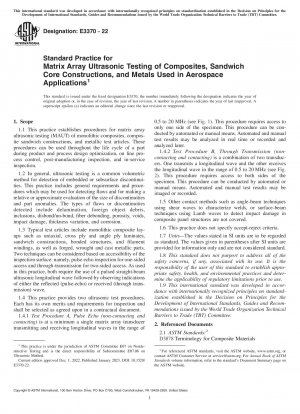ASTM E3370-22
Standard Practice for Matrix Array Ultrasonic Testing of Composites, Sandwich Core Constructions, and Metals Used in Aerospace Applications
- Standard No.
- ASTM E3370-22
- Release Date
- 2022
- Published By
- American Society for Testing and Materials (ASTM)
- Status
- Replace By
- ASTM E3370-23
- Latest
- ASTM E3370-23
- Scope
- 1.1 This practice establishes procedures for matrix array ultrasonic testing (MAUT) of monolithic composites, composite sandwich constructions, and metallic test articles. These procedures can be used throughout the life cycle of a part during product and process design optimization, on line process control, post-manufacturing inspection, and in-service inspection. 1.2 In general, ultrasonic testing is a common volumetric method for detection of embedded or subsurface discontinuities. This practice includes general requirements and procedures which may be used for detecting flaws and for making a relative or approximate evaluation of the size of discontinuities and part anomalies. The types of flaws or discontinuities detected include delamination, foreign object debris, inclusions, disbond/un-bond, fiber debonding, porosity, voids, impact damage, thickness variation, and corrosion. 1.3 Typical test articles include monolithic composite layups such as uniaxial, cross ply and angle ply laminates, sandwich constructions, bonded structures, and filament windings, as well as forged, wrought and cast metallic parts. Two techniques can be considered based on accessibility of the inspection surface: namely, pulse echo inspection for one-sided access and through-transmission for two-sided access. As used in this practice, both require the use of a pulsed straight-beam ultrasonic longitudinal wave followed by observing indications of either the reflected (pulse-echo) or received (through transmission) wave. 1.4 This practice provides two ultrasonic test procedures. Each has its own merits and requirements for inspection and shall be selected as agreed upon in a contractual document. 1.4.1 Test Procedure A, Pulse Echo (non-contacting and contacting) is at a minimum a single matrix array transducer transmitting and receiving longitudinal waves in the range of 0.5 to 20 MHz (see Fig. 1). This procedure requires access to only one side of the specimen. This procedure can be conducted by automated or manual means. Automated and manual test results may be analyzed in real time or recorded and analyzed later. 1.4.2 Test Procedure B, Through Transmission (noncontacting and contacting) is a combination of two transducers. One transmits a longitudinal wave and the other receives the longitudinal wave in the range of 0.5 to 20 MHz (see Fig. 2). This procedure requires access to both sides of the specimen. This procedure can be conducted by automated or manual means. Automated and manual test results may be imaged or recorded. 1.5 Other contact methods such as angle-beam techniques using shear waves to characterize welds, or surface-beam techniques using Lamb waves to detect impact damage in composite panel structures are not covered. 1.6 This practice does not specify accept-reject criteria. 1.7 Units—The values stated in SI units are to be regarded as standard. The values given in parentheses after SI units are provided for information only and are not considered standard. 1.8 This standard does not purport to address all of the safety concerns, if any, associated with its use. It is the responsibility of the user of this standard to establish appropriate safety, health, and environmental practices and determine the applicability of regulatory limitations prior to use. 1.9 This international standard was developed in accordance with internationally recognized principles on standardization established in the Decision on Principles for the Development of International Standards, Guides and Recommendations issued by the World Trade Organization Technical Barriers to Trade (TBT) Committee.
ASTM E3370-22 Referenced Document
- ASTM D3878 Standard Terminology Composite Materials
- ASTM D5687/D5687M Standard Guide for Preparation of Flat Composite Panels with Processing Guidelines for Specimen Preparation
- ASTM E1001 Standard Practice for Detection and Evaluation of Discontinuities by the Immersed Pulse-Echo Ultrasonic Method Using Longitudinal Waves
- ASTM E114 Standard Practice for Ultrasonic Pulse-Echo Straight-Beam Examination by the Contact Method
- ASTM E127 Standard Practice for Fabricating and Checking Aluminum Alloy Ultrasonic Standard Reference Blocks
- ASTM E1316 Standard Terminology for Nondestructive Examinations*, 2024-02-01 Update
- ASTM E1434 Standard Guide for Recording Mechanical Test Data of Fiber-Reinforced Composite Materials in Databases*, 2024-04-22 Update
- ASTM E1901 Standard Guide for Detection and Evaluation of Discontinuities by Contact Pulse-Echo Straight-Beam Ultrasonic Methods
- ASTM E2375 Standard Practice for Ultrasonic Testing of Wrought Products
- ASTM E2491 Standard Guide for Evaluating Performance Characteristics of Phased-Array Ultrasonic Testing Instruments and Systems*, 2023-06-01 Update
- ASTM E2580 Standard Practice for Ultrasonic Testing of Flat Panel Composites and Sandwich Core Materials Used in Aerospace Applications*, 2024-02-01 Update
- ASTM E494 Standard Practice for Measuring Ultrasonic Velocity in Materials
- ASTM E543 Standard Practice for Agencies Performing Nondestructive Testing
- ASTM E797/E797M Standard Practice for Measuring Thickness by Manual Ultrasonic Pulse-Echo Contact Method
- ISO 9712 Non-destructive testing — Qualification and certification of NDT personnel
ASTM E3370-22 history
- 2023 ASTM E3370-23 Standard Practice for Matrix Array Ultrasonic Testing of Composites, Sandwich Core Constructions, and Metals
- 2022 ASTM E3370-22 Standard Practice for Matrix Array Ultrasonic Testing of Composites, Sandwich Core Constructions, and Metals Used in Aerospace Applications
